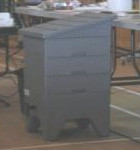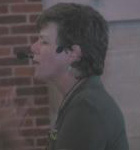Organic Magic With Worms
By: Rae Keen
 Cathy
Nesbitt treated us to an energetic lesson in vermicomposting (composting
with worms) at our July 7th general meeting. Cathy is an award-winning
environmentalist and the founder of Cathy’s Crawly Composters. She taught
us how worms are able to transform food scraps into a natural “garden
gold” fertilizer faster than traditional composting methods. And to
top it off, vermicomposting systems need very little space and can even
be kept indoors.
Cathy
Nesbitt treated us to an energetic lesson in vermicomposting (composting
with worms) at our July 7th general meeting. Cathy is an award-winning
environmentalist and the founder of Cathy’s Crawly Composters. She taught
us how worms are able to transform food scraps into a natural “garden
gold” fertilizer faster than traditional composting methods. And to
top it off, vermicomposting systems need very little space and can even
be kept indoors.
Red wiggler worms are used for vermicomposting, rather than the night crawler type of worms you see on the pavement after a rain shower. Red wigglers are hermaphrodites that are prolific breeders and have eggs. Each day, they eat about one-half of their weight in food scraps. These worms will live in any organic matter.
 To set up your
own worm bin, you can use virtually any container. For the bedding,
you need a carbon/nitrogen mix. Shredded paper, leaves or egg cartons
work well. You also need one litre of soil, crushed egg shells to balance
out the acidity, and water. Let the water stand for 24 hours to bring
it to room temperature and to eliminate the chlorine. The bedding should
have the consistency of a wrung-out sponge.
To set up your
own worm bin, you can use virtually any container. For the bedding,
you need a carbon/nitrogen mix. Shredded paper, leaves or egg cartons
work well. You also need one litre of soil, crushed egg shells to balance
out the acidity, and water. Let the water stand for 24 hours to bring
it to room temperature and to eliminate the chlorine. The bedding should
have the consistency of a wrung-out sponge.
To feed the worms, pull up the bedding and then put on the food scraps. There is a very short list of what not to feed them: meat, dairy and sauces. To help prevent pesky fruit flies, rinse off the food scraps. One pound of worms (800-1000 worms) can be fed about three pounds of food each week. If you chop up the food scraps, the worms will consume the food more quickly. Vermicomposting is odourless because the worms eat the decomposing matter, leaving a fresh, earthy scent.
If you put red wigglers in your backyard composter, they will do the turning for you! They will speed up the composting process and create a finer product.
To harvest the worm castings, first divide the contents of your container into piles. Then shine a light onto the top. This will cause the worms to move to the bottom of the container. Next, remove the top of the piles and collect the worms on the bottom. You can then place the worms in new bedding.
Worms produce “magic soil” in which you can grow anything. Also, worm castings are now thought to prevent plant diseases. When using the worm compost, Cathy suggests 80 percent soil and 20 percent worm castings.
As Cathy says, “Worms are not an impulse buy.” Indeed Cathy was afraid of worms until she learned about their amazing abilities. She now considers worms to be the “coolest creatures.” Not surprisingly, Cathy has discovered that kids love vermicomposting because they are fascinated by the worms. What a terrific way to introduce children to composting!
To learn more about the organic magic of worms, you can visit Cathy Nesbitt’s website at www.cathyscomposters.com.
Back to Articles
